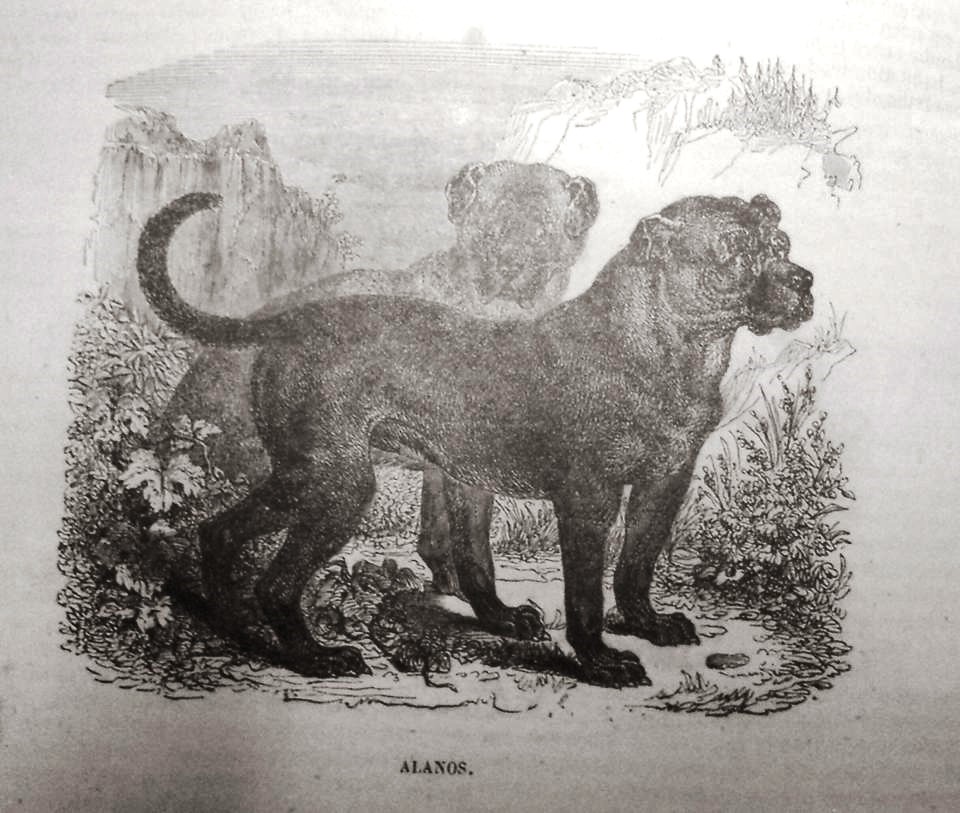Alanos
The three animal kingdoms .( Zoology).
Author: D. Eduardo Chao (1852).
Retrato: Alanos
wrongly posted as Cuban Dogges very often.
-
- · gsicard
- ·
Apart from the geographical location was there a big difference between the Alano Espanol and the Cuban Dogge? I think there were some good resemblance in form and function.
-
The cuban dogge has bloodhound blood, or some kind of scent hound, since the heavy Alano or spanish bulldog was a dog intended to grip the prey in a short range, the Alano was not a scent hound, was a running sight hound for large distances, the original Alanos and Vandals tribes need a kind of grayhound since they were horsemen, a sight hound in the steppes for hunting and the grip of a mastiff. (the steppes Taigan Kirguiz hound, the Kretan Hound Kritikos Lagonikos and the anatolian Shepherd dog gave birth to the bulgarian Shepherd) Probably the original Alanos that arrive to Spain, were Taigan and indian Mastiff cross, since the Assyrians were prone to marry their princess with the Sarmatians/Alaunts princess to keep peace in the Sarmatian steppes, as documented in the clay tablets of Assyria, once arrived to Europe, they probably crossed this dogs with local molossers (Belgian mastiffs were very famous in the roman era, like the British Pugnaces, and Spain and France received a lot of trade, and the entire mediterranean shores), Switzerland, Germany and Ireland have some of the oldest remains of paleolitic dogs, the have their own races of dogs. The holly Grial will be find genetics of the older alans skeleton, of current times, and ancien times, and compare those.
Under this assumptions, in Cuba, Brasil, México and Southern USA, they needed bloodhound mastiff mix with scent capabilitis, and the new born Dogo Cubano, or Cuban Bloodhound suits the need of a dog to track "cimarron" slaves, of was fugitives like the case of México in the American-Mexican war.
In the Saint Jago Church, in the caribean, is documented that the english brough Mastiffs with them, and probably spread those dogs in the rest of the caribean islands, and mix with the spanish dogs, and bloodhounds. That is a thogh only, but the first line is well documented by MB Wynn, he also said on his words that the Spanish Bullmastiff, the Cuban Bullmastiff, were so simmilar, in those times. The oldest prints of the bullmastiff, may be similar to the ancient cuban bullmastiff (cited by MB Wynn) or Cuban Dogge.
Refference by MB Wynn:
It has been presumed without any decided proof that the
Spanish bulldog was originally imported from England, but
the truth of this is far from certain, and having inspected
some of the most noted Spanish bulldogs and Cuban bull
mastiffs, that have been imported to this country, I have
come to the conclusion that although the Spanish bulldog is
or was a remnant of the true Pugnaces, yet it differs considerably
to the British bulldog of modern ages, in more
characteristics than its greater size. Col. H. Smith in
Naturalists Library, states that he was informed in the \Yest
Indies by some cattle dealers, who cultivated the breed, that
the Cuban mastift was introduced from England about 1560,
and that they were first kept at a monastry in the ancient
capital of St. Jago, acording to accounts received from a
priest by the cattle dealers who informed Col. II. Smith. -
Ivan,
I just saw your post and read it. Very well done. Thank you very much.





